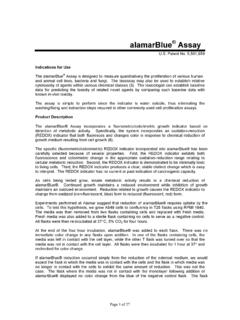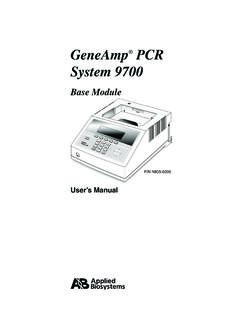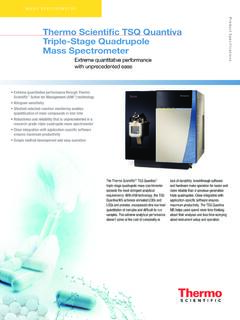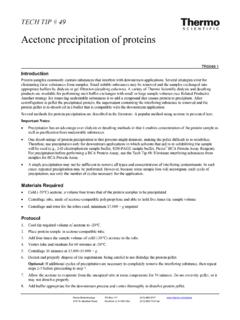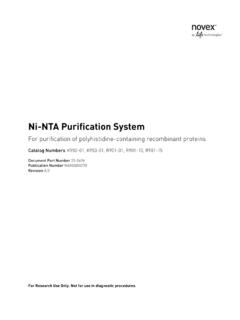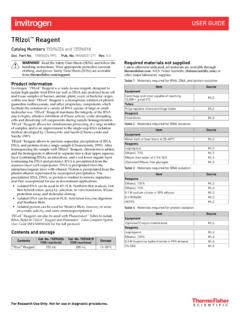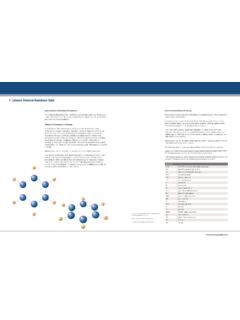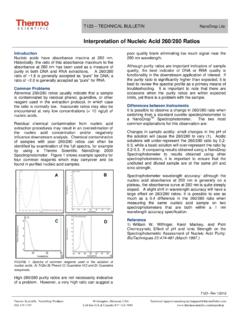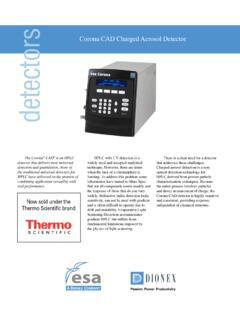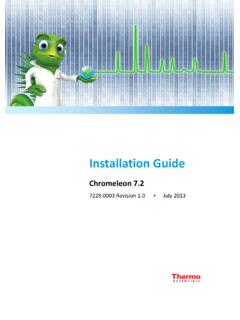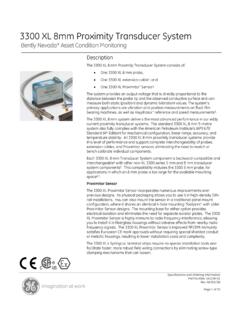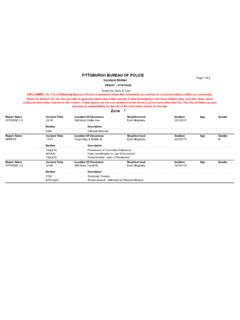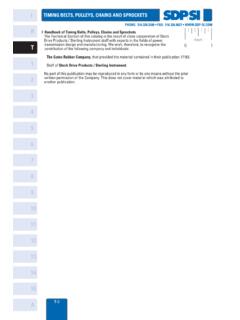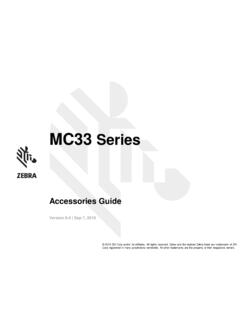Transcription of RiboGreen Assay for RNA Quantitation
1 PROTOCOL NanoDrop 3300 Thermo Fisher Scientific - NanoDrop products Wilmington, Delaware USA Technical support: 302-479-7707 The RiboGreen dye is a fluorescent nucleic acid stain for quantitating intact RNA. Used in conjunction with the micro-volume capability of the Thermo Scientific NanoDrop 3300 Fluorospectrometer, the RiboGreen Assay provides a highly sensitive means of RNA Quantitation with minimal consump-tion of sample. The main disadvantage of general UV spectros-copy for RNA Quantitation is the contribution of signal from degraded RNA and other contaminants, such as proteins and extraction buffers.
2 RiboGreen reagent circumvents such con-tributions from interfering substances by exhibiting an emission maximum at 530nm when bound specifically to intact RNA (unbound RiboGreen reagent exhibits minimal fluorescence in solution). The ability of the NanoDrop 3300 to measure as little as 1 ul of sample, allows significantly scaled-down reac-tion volumes, thereby using only a fraction of sample com-monly needed for conventional cuvette-based fluorometers. The NanoDrop 3300 has demonstrated a detection range for RNA of 25 ng/ml - 1000 ng/ml when using a high concentra-tion of RiboGreen dye (1:200 dilution), and 5 ng/ml - 50 ng/ml when using a 1:2000 dilution of RiboGreen dye. (The following protocol is an adaptation of the Molecular ProbesTM RNA Reagent Kit product information sheet.)
3 RiboGreen Assay Supplies Equipment: NanoDrop 3300 Fluorospectrometer 2uL pipettor (low retention nuclease free pipette tips) Materials: Low lint laboratory wipes Nuclease free amber or foil covered ml polypropyl-ene tubes RNase inhibitor wipe or solution Polypropylene bottles, vials, and tubes Reagents: RiboGreen RNA reagent kit (Molecular Probes catalog # R11490) Includes 20X TE. DEPC treated water RiboGreen Assay Suggestions Aliquot dye concentrate into amber screw top tubes. Store at -20 C. Wipe down bench space, pipettes, and racks with RNase inhibitor before starting Assay . Change gloves often to minimize nuclease contamination. RiboGreen Assay Protocol 1. Equilibrate the 20X TE buffer, RiboGreen reagent (200X concentrate and DEPC treated dH2O to room tempera-ture.)
4 Protect from light. 2. Prepare 1X TE with DEPC treated water. The volume needed depends on the total number of samples to be measured and the volume of RiboGreen working solution. 3. Dilute the RiboGreen Dye stock in two stages depending on RNA standard concentration range. (Prepare fresh as the diluted dye is stable for only a few hours. Protect all stockes from light. 4. Thaw the standard and unknown RNA samples. Once thawed, thoroughly mix each individual solution gently . 5. Prepare serially diluted RNA standards to 2X final concen-trations in nuclease free vials or tubes (please refer to the example standard curve dilution series on page 2). 6. Aliquot one volume of diluted unknown RNA samples into appropriately labeled nuclease free amber tubes.)
5 Note: It is recommended that RNAs be diluted into 1X TE at an estimated 2x concentration which will fall in the mid-dle of the standard curve. 7. Transfer an equal volume of the appropriate diluted Ri-boGreen dye solution to each amber tube containing ei-ther the 2X standard RNA solution or unknown sample. 8. Prepare the Reference solution (negative control) by add-ing equal volumes of 1X TE and RiboGreen working solution. 9. Mix each standard dilution and unknown sample thor-oughly and allow to equilibrate at room temperature for 5 minutes. Proceed to Standard Curve Protocol (page 2). High RNA Quantitation range (25 ng/ml 1000 ng/ml) Dilute the RiboGreen stock (200X concentrate) by transferring 995 ul of 1X TE and 5 ul of the dye stock to a amber snap cap tube.
6 Mix thoroughly. Low RNA Quantitation range (5 ng/ml 50 ng/ml) Dilute the 1X dye in the previous step ten (10) fold further by transferring 900ul of 1X TE and 100ul of the 1X dye dilution to a amber snap cap tube,. Mix thoroughly. RiboGreen Assay for RNA Quantitation PROTOCOL NanoDrop 3300 2 Rev 4/08 Thermo Fisher Scientific - NanoDrop products Wilmington, Delaware USA Technical support: 302-479-7707 Standard Curve Protocol 1. Clean both sampling pedestals with 2 uL of nuclease free deionized water. 2. Open upper arm and firmly blot the two pedestals with a dry lab wipe.
7 Make sure there are no traces of lint on the pedestals before continuing. 3. Open the operating software. Click on the Nucleic Acid Quantitation button and select the RiboGreen method. 4. Add 2 uL of Assay buffer (no dye, no sample) to the lower pedestal. Lower the arm and click F3 or the Blank button. When the measurement is complete, lift the arm and use a dry laboratory wipe to blot the buffer from both the bot-tom and upper measurement surfaces. Use a fresh aliquot of buffer to verify a proper baseline. 5. Under Measurement type, click on the Standards tab. High-light the Reference standard. 6. Mix the reference solution ( Assay buffer and dye, no sample) briefly and transfer 2 uL of the solution onto the lower pedestal.
8 Lower the arm and click F1 or the Measure but-ton. A pop up window will ask for confirmation of the units. (Recommended ng/mL or pg/uL) 7. Measure up to 5 replicates of the reference solution using a fresh 2 uL aliquot for each measurement. 8. Select Standard 1 to enter a value. Enter values for up to 7 standards. 9. Mix the standard solution briefly and transfer 2 uL onto the lower pedestal. Lower the arm and click F1 or the Meas-ure button. Measure up to 5 replicates of each standard using a fresh 2 uL aliquot for each measurement. 10. Once the standard curve is completed, select the Standard Curve Type (Interpolation, Linear, 2 polynomial, 3 poly-nomial) that best fits the standards data set. 11. Click on the Sample tab under Measurement Type, and enter the unknown samples respective ID information.
9 If a dilution of the unknown sample was made, enter the dilu-tion factor in the box below the sample ID window. 12. Add 2 ul of the sample and use the F1 key or click the Measure button to initiate the measurement cycle. Use a fresh aliquot of sample for each measurement. High RNA concentration range Example of standard curve dilution series Low RNA concentration range. Example of standard curve dilution series Example spectrum of RiboGreen RNA sample Stock RNA (ng/ml) 2X RNA volume (ul) 1X TE buffer volume (ul) 2X RNA standard (ng/ml) Final RNA (ng/ml) 2000 10* 0 2000 1000 2000 10** 10 1000 500 1000 10 10 500 250 500 10 10 250 125 250 5 20 50 25 Stock RNA (ng/ml) 2X RNA volume (ul) 1X TE buffer volume (ul) 2X RNA standard (ng/ml) Final RNA (ng/ml)
10 100 10* 0 100 50 100 20** 5 80 40 80 10 10 40 20 40 10 10 20 10 20 10 10 10 5
